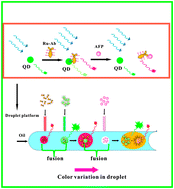A fluorescence-based colorimetric droplet platform for biosensor application to the detection of α-fetoprotein†
Abstract
Droplet methods have been successfully applied in DNA hybridization analysis and protein-protein interaction. Existing assay methods implemented in droplet platforms are severely limited by expensive and high-maintenance equipment. As a convenient detection method, colorimetry provides a new path for microscale assay since it can enhance assay efficiency and simplify the detection procedure. Here, a microscale immunoassay for α-fetoprotein (AFP) was developed for the first time by the incorporation of colorimetry and droplet platform. Ru(bpy)2(mcbpy-O-Su-ester)(PF6)2 complex (Ru) was coupled with the monoclonal antibody (Ab) of AFP to form a stable red Ru–Ab complex both as a quencher for green CdTe quantum dots (QDs) and as a capture probe for AFP. In the absence of AFP, the mixed droplet showed a red color. With the increase of AFP concentration, the color change of the droplet was from red to green as a result of the competition of AFP with QDs for Ru–Ab. The biosensor exhibited not only good sensitivity and specificity for AFP with a detection limit of 0.06 ng ml−1, but also satisfactory performance in diluted human sera with a detection limit of 0.4 ng ml−1. Notably, a visual droplet platform for screening cancer biomarkers by the naked eye based on this principle is anticipated.


 Please wait while we load your content...
Please wait while we load your content...